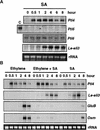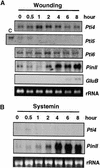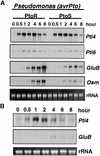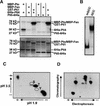Pti4 is induced by ethylene and salicylic acid, and its product is phosphorylated by the Pto kinase
- PMID: 10810149
- PMCID: PMC139926
- DOI: 10.1105/tpc.12.5.771
Pti4 is induced by ethylene and salicylic acid, and its product is phosphorylated by the Pto kinase
Abstract
The tomato Pti4 gene encodes a transcription factor that was identified on the basis of its specific interaction with the product of the Pto disease resistance gene in a yeast two-hybrid system. We show here that the Pti4 protein specifically binds the GCC-box cis element, which is present in the promoter region of many pathogenesis-related (PR) genes. Expression of the Pti4 gene in tomato leaves was rapidly induced by ethylene and by infection with Pseudomonas syringae pv tomato, and this induction preceded expression of GCC-box-containing PR genes. Although salicylic acid also induced Pti4 gene expression, it did not induce GCC-box PR genes. Rather, salicylic acid antagonized ethylene-mediated expression of GCC-box PR genes. We demonstrate that the Pti4 protein is specifically phosphorylated by the Pto kinase and that this phosphorylation enhances binding of Pti4 to the GCC box. In addition, induced overexpression of Pto and Pti4 in tomato leaves resulted in a concomitant increase in GCC-box PR genes. Our results support a model in which phosphorylation of the Pti4 protein by the Pto kinase enhances the ability of Pti4 to activate expression of GCC-box PR genes in tomato.
Figures










Similar articles
-
The tomato transcription factor Pti4 regulates defense-related gene expression via GCC box and non-GCC box cis elements.Plant Cell. 2003 Dec;15(12):3033-50. doi: 10.1105/tpc.017574. Epub 2003 Nov 20. Plant Cell. 2003. PMID: 14630974 Free PMC article.
-
Tomato transcription factors pti4, pti5, and pti6 activate defense responses when expressed in Arabidopsis.Plant Cell. 2002 Apr;14(4):817-31. doi: 10.1105/tpc.000794. Plant Cell. 2002. PMID: 11971137 Free PMC article.
-
Functional analysis of tomato Pti4 in Arabidopsis.Plant Physiol. 2002 Jan;128(1):30-7. Plant Physiol. 2002. PMID: 11788750 Free PMC article.
-
Regulation of ethylene-induced transcription of defense genes.Plant Cell Physiol. 2000 Nov;41(11):1187-92. doi: 10.1093/pcp/pcd057. Plant Cell Physiol. 2000. PMID: 11092902 Review.
-
Pto Interaction Proteins: Critical Regulators in Plant Development and Stress Response.Front Plant Sci. 2022 Mar 10;13:774229. doi: 10.3389/fpls.2022.774229. eCollection 2022. Front Plant Sci. 2022. PMID: 35360329 Free PMC article. Review.
Cited by
-
Pathogen-induced ERF68 regulates hypersensitive cell death in tomato.Mol Plant Pathol. 2017 Oct;18(8):1062-1074. doi: 10.1111/mpp.12460. Epub 2016 Sep 1. Mol Plant Pathol. 2017. PMID: 27415633 Free PMC article.
-
The ethylene-, jasmonate-, abscisic acid- and NaCl-responsive tomato transcription factor JERF1 modulates expression of GCC box-containing genes and salt tolerance in tobacco.Planta. 2004 Dec;220(2):262-70. doi: 10.1007/s00425-004-1347-x. Epub 2004 Aug 5. Planta. 2004. PMID: 15300440
-
Ectopic expression of an EAR motif deletion mutant of SlERF3 enhances tolerance to salt stress and Ralstonia solanacearum in tomato.Planta. 2010 Oct;232(5):1075-86. doi: 10.1007/s00425-010-1235-5. Epub 2010 Aug 10. Planta. 2010. PMID: 20697739
-
Molecular characterization of a novel lipase-like pathogen-inducible gene family of Arabidopsis.Plant Physiol. 2003 Aug;132(4):2230-9. doi: 10.1104/pp.103.025312. Plant Physiol. 2003. PMID: 12913177 Free PMC article.
-
Expressing TERF1 in tobacco enhances drought tolerance and abscisic acid sensitivity during seedling development.Planta. 2005 Oct;222(3):494-501. doi: 10.1007/s00425-005-1564-y. Epub 2005 May 4. Planta. 2005. PMID: 15871029
References
-
- Abeles, F.B., Morgan, P.W., and Saltveit, M.E., Jr. (1992). Ethylene in Plant Biology. (San Diego, CA: Academic Press).
-
- Ausubel, F.M., Brent, R., Kingston, R.E., Moore, D.D., Smith, J.A., Seidman, J.G., and Struhl, K., eds (1987). Protocols in Molecular Biology. (New York: John Wiley).
-
- Broglie, K.E., Chet, I., Holliday, M., Cressman, R., Biddle, P., Knowlton, S., Mauvais, C.J., and Broglie, R. (1991). Transgenic plants with enhanced resistance to the fungal pathogen Rhizoctonia solani. Science 254, 1194–1197. - PubMed
-
- Buchel, A.S., Molemkamp, R., Bol, J.F., and Linthorst, H.J.M. (1996). The PR-1a promoter contains a number of elements that bind GT-1–like nuclear factors with different affinity. Plant Mol. Biol. 30, 493–504. - PubMed
Publication types
MeSH terms
Substances
LinkOut - more resources
Full Text Sources
Other Literature Sources
Research Materials

